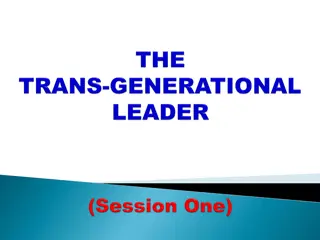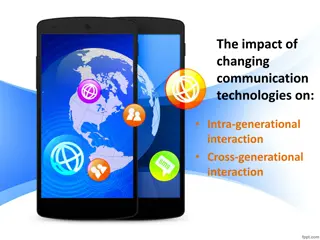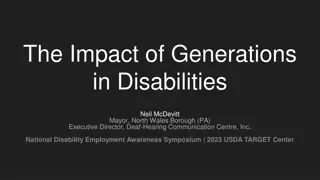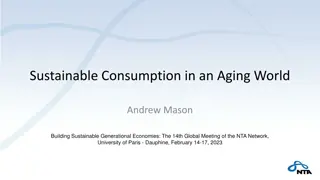Understanding Age Dynamics in the Workplace: Generational Insights
Exploring the different generations in the workplace, from Traditionalists to Baby Boomers, Generation X, and Millennials, highlighting their unique traits, values, and work approaches. Understanding these age dynamics is crucial for effective collaboration and leadership in modern organizations.
Download Presentation

Please find below an Image/Link to download the presentation.
The content on the website is provided AS IS for your information and personal use only. It may not be sold, licensed, or shared on other websites without obtaining consent from the author. Download presentation by click this link. If you encounter any issues during the download, it is possible that the publisher has removed the file from their server.
E N D
Presentation Transcript
UNDERSTAND AGE DYNAMICS IN THE WORKPLACE UNIT 1, TOPIC 1
Types Types of of generations generations Veterans (or Traditionalists) - born in or before 1945; Baby boomers - between 1946 and 1965; Generation X - between 1965 and 1980; Millennials - between 1980 and 2000; Generation Z - as of 2000.
Veterans Veterans ( (or or Traditionalists Traditionalists) ) - - born before before 1945 1945 born in in or or Even if Baby boomers , Generation X , and Millennials are the main generations in the workplace today (Houck, 2011), there s a need to talk about the Veterans (or Traditionalists). Includes people born in or before 1945, have an ideology of life-time employment with strong value hierarchies (Stanley, 2010).
Professional respect and image, loyalty and dedication are personality traits that, generally, the Traditionalists have. Through the life-time employment idea, they believe that hard work will produce rewards. They tended to be uncomfortable with change and tend to favour command and control management/leadership styles (Stanley, 2010). They maintain an extremely methodical and exact line, based on a belief and respect of and for authority, duty, honour, dedication and sacrifice (Calhoun & Strasser 2005, Gursory et al. 2008).
Baby Baby boomers boomers - - between between1946 1946 and and 1965 1965 On the other hand, the Baby boomers were born between 1946 and 1965 (Fingerman, Pillemer, Silverstein & Suitor, 2012). Some authors believe that they live in a era of relative optimism, opportunity and progress (Stanley, 2010). Generally, they grew up in a secure jobs and good education framework given the post-war prosperity. They have values as optimism, personal growth, health and wellness and involvement (Duchscher & Cowan 2004, Weingarten 2009). The social, financial and political situation such as women s movement, the sexual revolution, rising divorce rates, and enhanced educational opportunities allowed them to grown quite differently of their parents
Generation Generation X X The next generation after the Baby boomers is the Generation X . They re the type of people that live to work and were born between 1965 and 1980 (Stanley, 2010). Given the social and financial context, this generation had another kind of beliefs development Generation X appear after the Baby Boomers, being born between 1965 and 1980 into a time of rapid change, with changing social and economic factors impacting on their education and development.
Generation Generation X X They grew up into an environment of two career families, rising divorce rates, downsizing and the dawn of the age of rapid developments in technology and communication. Generation X focused on personal growth, aggressively questioning the status quo and authority and they recognized that job security was anything of the past. Their core values focused on thinking globally, balance, technological literacy, having fun, travel, independence, diversity and informality (Gursory et al. 2008, Weingarten 2009). Generation X do not place so much emphasis on work and feel work should not be too serious or formal, in fact, work should be fun (Irvine 2010).
Xennials Xennials Xennials were born in a quiet break between two distinct generations (Stankorb and Oelbaum, 2014), wedged between Generation X and the Millennials (Dhami, 2014). They form a link between Gen Xers and Millennials (Lamagna, 2015) though they sometimes feel like generational misfits because they do not identify with either label (Stankorb and Oelbaum, 2014). Some researchers push this microgeneration on to Millennials (Garvey, 2015), while most place Xennials at the end of Generation X (Shafrir, 2011).
Xennials Xennials Xennials survived their toughest growing up years without the intrusion of social media and for the children born just after them, the entire world changed (Garvey, 2015). Shared experiences help Xennials determine more of who they are, which is a trait they have in common with Gen Xers (Shafrir, 2011). Examples of the Xennial microgeneration are portrayed in television shows such as My So Called Life, Dawson s Creek (Stankorb and Oelbaum, 2014), and Saved bythe Bell (Shafrir, 2011) and in movies like Empire Records (Stankorb and Oelbaum, 2014)
Xennials Xennials Xennials did not grow up on social media, they were already adults when instant messaging became truly popular. Nowadays they use social media but can still remember the days without it. Xennials were the first generation to have computers at home, they adapt to technology easily and are still very impressed by it today.
Millennials Millennials / / Generation Generation Y Y Generation Y or Millennials are the latest generation that has joined the workplace. Many from this generation are now in the late 20s but there isn t much research on them done as of yet. There isn t much information about their workplace preferences yet but very recent studies suggest that Millennials thrive in collaborative and interactive workplaces. This generation values working in a team and value continuous development.
Generation Generation Z Z Generation Z is the upcoming generation that is expected to join the workplace over the next 5 years. Born on or after 1995, they are rapidly occupying the consumer market. Although most of their natives are still children or adolescents, the largest representatives of the generation are already entering the labor market. Although often regarded as similar to Millennials, they are considered to be a highly advanced generation, technologically, socially and morally.

















































